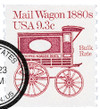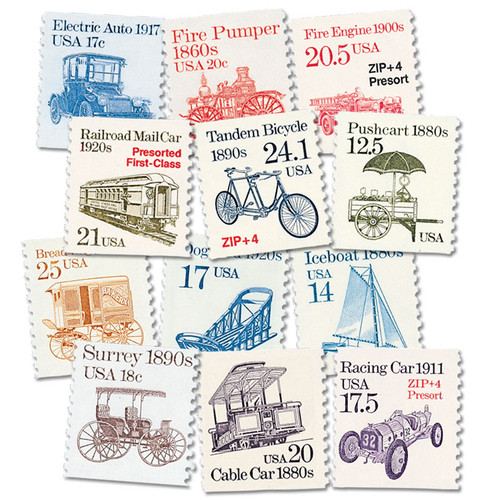
1981 9.3c Transportation Series: Mail Wagon, 1880s
# 1903 - 1981 9.3c Transportation Series: Mail Wagon, 1880s
$0.35 - $10.50
U.S. #1903
1981 9.3¢ Mail Wagon
Transportation Series
1981 9.3¢ Mail Wagon
Transportation Series
Issue Date: December 15, 1983
City: Shreveport, LA
City: Shreveport, LA
Printed By: Bureau of Engraving and Printing
Printing Method: Engraved
Perforations: 10 vertically
Color: Carmine rose
In 1896, the Postal Department established Rural Free Delivery, a development that led to the use of the Mail Wagon. The carriers who delivered mail to homes and businesses became a traveling post office where patrons could buy stamps, register their mail, and even purchase money orders. Trained horses could go between stops without much attention from the driver, leaving his hands free to sort and postmark mail.
The Transportation Series
A ground-breaking stamp was quietly issued on May 18, 1981. For the first time in U.S. history, a coil stamp featured its own unique design rather than simply copying that of the current definitive stamp. Fifty more coil stamps would be issued over the course of the next 15 years, each picturing a different mode of transportation.
The various denominations provided face values to exactly match the rates for several categories of Third Class mail (bulk rate and quantity-discounted mail). As the rates changed, new stamps with new values were added. Never before had a stamp series included so many fractional cent values.
Most of the stamps in the Transportation Series were printed by the Bureau of Engraving and Printing, although a few were printed by private contractors. All but a few of the later stamps were produced by engraved intaglio. Differences in precancels, tagging, paper and gum provide a large number of varieties.
U.S. #1903
1981 9.3¢ Mail Wagon
Transportation Series
1981 9.3¢ Mail Wagon
Transportation Series
Issue Date: December 15, 1983
City: Shreveport, LA
City: Shreveport, LA
Printed By: Bureau of Engraving and Printing
Printing Method: Engraved
Perforations: 10 vertically
Color: Carmine rose
In 1896, the Postal Department established Rural Free Delivery, a development that led to the use of the Mail Wagon. The carriers who delivered mail to homes and businesses became a traveling post office where patrons could buy stamps, register their mail, and even purchase money orders. Trained horses could go between stops without much attention from the driver, leaving his hands free to sort and postmark mail.
The Transportation Series
A ground-breaking stamp was quietly issued on May 18, 1981. For the first time in U.S. history, a coil stamp featured its own unique design rather than simply copying that of the current definitive stamp. Fifty more coil stamps would be issued over the course of the next 15 years, each picturing a different mode of transportation.
The various denominations provided face values to exactly match the rates for several categories of Third Class mail (bulk rate and quantity-discounted mail). As the rates changed, new stamps with new values were added. Never before had a stamp series included so many fractional cent values.
Most of the stamps in the Transportation Series were printed by the Bureau of Engraving and Printing, although a few were printed by private contractors. All but a few of the later stamps were produced by engraved intaglio. Differences in precancels, tagging, paper and gum provide a large number of varieties.





















